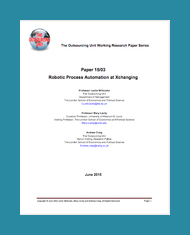[Case Study] Robotic Process Automation at Xchanging
Add bookmark
Recent interest in service automation has escalated with the introduction of technologies including Robotic Process Automation (RPA) and Cognitive Intelligence (CI) tools. Many potential adopters remain skeptical about the claims surrounding promised business value, however, and are looking for exposure to actual and realistic client adoption stories.
Academic researchers can help by objectively researching actual RPA and CI implementation case studies, assessing what the software can and cannot yet do, andextracting lessons on realizing its value.
The academic researchers at the London School of Economic's Outsourcing Unit (OU) have been assessing the current and long-term effects of business services automation. From years of research on back offices, OU knows that low-performing back offices are transformed to high-performance through six transformation levers:
-
centralized physical facilities and budgets
-
standardized processes across business units
-
optimized processes to reduce errors and waste
-
relocation from high-cost to low-cost destinations
-
technology enabled with, for example, self-service portals
-
automated services.
For the past 5 years, companies have widely adopted the first 5 levers to the point that these have become institutionalized. It is only now that the real power of service automation is being unleashed. Where over 35% of transactions are automated, this is frequently refered to as "Robotic Process Automation" (RPA).






























